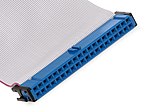
Back مقبس تكنولوجي متقدم متوازي Arabic IDE disklər Azerbaijani Integrated Drive Electronics BS Parallel ATA Catalan Advanced Technology Attachment Czech ATA/ATAPI German Integrated Drive Electronics Greek Integrated Drive Electronics Spanish Paralleel-ATA Estonian واسط الکترونیکی یکپارچه دیسکگردان Persian
 | |||
 Two ATA motherboard sockets above, with an ATA connector below | |||
| Type | Internal storage device connector | ||
|---|---|---|---|
| Production history | |||
| Designer |
Western Digital and Compaq, subsequently enhanced by many others | ||
| Designed | 1986 | ||
| Superseded by | Serial ATA (2003) | ||
| General specifications | |||
| Hot pluggable | No | ||
| External | No | ||
| Cable | 40 or 80 conductor ribbon cable | ||
| Pins | 40 | ||
| Data | |||
| Width | 16 bits | ||
| Bitrate |
Half-duplex: 8.3 MB/s per ATA channel originally later 33, 66, 100 and 133 MB/s per ATA channel | ||
| Max. devices | Two | ||
| Protocol | Parallel | ||
| Pinout | |||
|
| |||
| Pin 1 | Reset | ||
| Pin 2 | Ground | ||
| Pin 3 | Data 7 | ||
| Pin 4 | Data 8 | ||
| Pin 5 | Data 6 | ||
| Pin 6 | Data 9 | ||
| Pin 7 | Data 5 | ||
| Pin 8 | Data 10 | ||
| Pin 9 | Data 4 | ||
| Pin 10 | Data 11 | ||
| Pin 11 | Data 3 | ||
| Pin 12 | Data 12 | ||
| Pin 13 | Data 2 | ||
| Pin 14 | Data 13 | ||
| Pin 15 | Data 1 | ||
| Pin 16 | Data 14 | ||
| Pin 17 | Data 0 | ||
| Pin 18 | Data 15 | ||
| Pin 19 | Ground | ||
| Pin 20 | Key or VCC_in | ||
| Pin 21 | DDRQ | ||
| Pin 22 | Ground | ||
| Pin 23 | I/O write | ||
| Pin 24 | Ground | ||
| Pin 25 | I/O read | ||
| Pin 26 | Ground | ||
| Pin 27 | IOCHRDY | ||
| Pin 28 | Cable select | ||
| Pin 29 | DDACK | ||
| Pin 30 | Ground | ||
| Pin 31 | IRQ | ||
| Pin 32 | No connect | ||
| Pin 33 | Addr 1 | ||
| Pin 34 | GPIO_DMA66_Detect | ||
| Pin 35 | Addr 0 | ||
| Pin 36 | Addr 2 | ||
| Pin 37 | Chip select 1P | ||
| Pin 38 | Chip select 3P | ||
| Pin 39 | Activity | ||
| Pin 40 | Ground | ||
Parallel ATA (PATA), originally AT Attachment, also known as IDE or Integrated Drive Electronics, is a standard interface designed for IBM PC-compatible computers. It was first developed by Western Digital and Compaq in 1986 for compatible hard drives and CD or DVD drives. The connection is used for storage devices such as hard disk drives, floppy disk drives, optical disc drives, and tape drives in computers.
The standard is maintained by the X3/INCITS committee.[1] It uses the underlying AT Attachment (ATA) and AT Attachment Packet Interface (ATAPI) standards.
The Parallel ATA standard is the result of a long history of incremental technical development, which began with the original AT Attachment interface, developed for use in early PC AT equipment. The ATA interface itself evolved in several stages from Western Digital's original Integrated Drive Electronics (IDE) interface. As a result, many near-synonyms for ATA/ATAPI and its previous incarnations are still in common informal use, in particular Extended IDE (EIDE) and Ultra ATA (UATA). After the introduction of SATA in 2003, the original ATA was renamed to Parallel ATA, or PATA for short.
Parallel ATA cables have a maximum allowable length of 18 in (457 mm).[2][3] Because of this limit, the technology normally appears as an internal computer storage interface. For many years, ATA provided the most common and the least expensive interface for this application. It has largely been replaced by SATA in newer systems.
- ^ "t13.org".
- ^ "Serial ATA: A Comparison with Ultra ATA Technology" (PDF). Seagate Technology. Archived from the original (PDF) on 2012-01-05. Retrieved 23 January 2012.
- ^ Frawley, Lucas. "Parallel vs. Serial ATA". What Is? The Information for Your Computer Questions. Directron.com. Archived from the original on 1 August 2003. Retrieved 23 January 2012.
© MMXXIII Rich X Search. We shall prevail. All rights reserved. Rich X Search